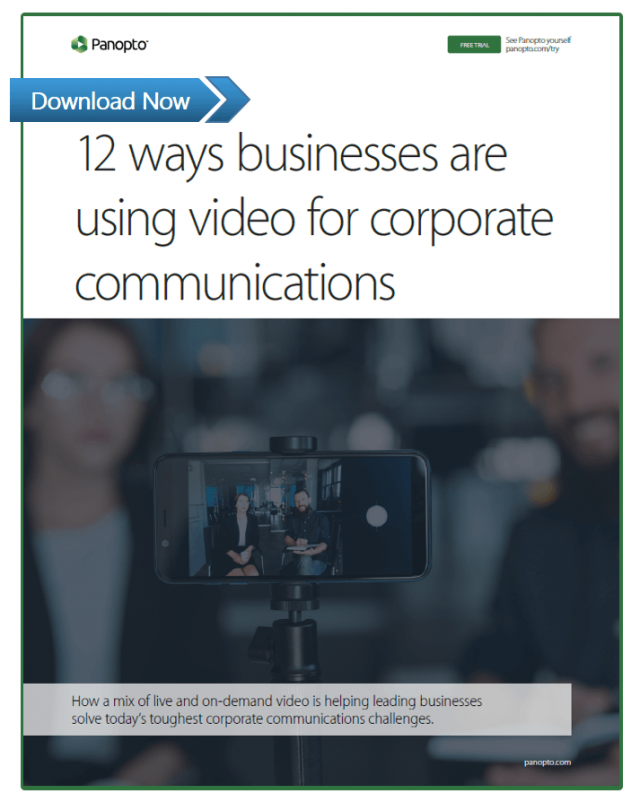- Communications
Solving Today’s Toughest Corporate Communications Challenges

“Action” is the mantra of the modern workplace. Teams work in “sprints.” They “move fast and break things.” And while an MBA might still help you get ahead, so will earning a reputation for three others letters — the ability to “GSD,” or “Get [Stuff] Done.”
The modern work environment has adapted to follow suit. The average employee is now far more likely to sit in front of multiple monitors, as well as to be able to connect to office technologies remotely from their personal mobile devices. Along with the now-familiar demands of email and calendar reminders, the average knowledge worker is now also keeping up with team messaging tools like Slack and Microsoft Teams, project management tools like Trello and Basecamp, social tools like Salesforce Chatter and Jive, among countless others.
It’s a reality that’s often indistinguishable from pure chaos.
And it’s a reality that’s created some real challenges for corporate communications professionals.
Even though employees regularly request more transparency from the top and more detailed insights on what’s going on and where the company is headed, they just as often miss the communications you’re already sending. Important news gets lost in the shuffle of their inboxes, overlooked in messaging apps, or skipped entirely because they can’t attend a meeting.
Communicating In An Attention Economy
Attention has become the world’s most scarce resource. And unfortunately, in a competition for attention, you can’t beat text with more text.
But that doesn’t mean we need to throw out the corporate communications playbook. Instead, leaders in the field have already begun rethinking the ways they communicate.
With so much communication now taking place digitally, delivering a message face-to-face carries more power than ever before. And that’s not only because face-to-face communication naturally includes all those nonverbal cues like body language, facial expressions, and tone that we’ve all heard account for more than half of every message we share in-person (although that certainly adds value).
Rather, the power of face-to-face communication in the modern workplace can be seen as an extension of the argument that “the medium is the message.”
And that, in turn, is why face-to-face interactions are so much more effective at building trust, understanding, and a real sense of shared goals within a business.
The Practical Challenge Of In-Person Communications
Of course, most professionals don’t doubt the value of in-person communication.
Instead, the issue is usually that, in today’s busy and scattered work environments, it’s seldom possible for everyone to be in the same room at the same time. And often that makes truly face-to-face interactions inconvenient at best and outright impossible at worst.
But that doesn’t mean there isn’t a strong “next-best” option.
According to Forrester Research, 75 percent of employees say they’d rather watch a video than read an email or text. And that’s not just among Millennials or Gen Z new hires — when given a choice between text and video, Forbes reports that 3 in 4 senior executives will choose to watch rather than read.
Today, corporate communications professionals are increasingly leveraging live and on-demand video to break through the noise and more effectively engage and inform employees.
How Video Is Helping Solve Today’s Toughest Corporate Communications Challenges
Successful corporate communications strategies support businesses in many ways, including helping to attract and retain talent, uniting and motivating workforces to work together towards strategic objectives, and earning trust from public consumers and financial investors.
But what happens when we don’t get it right?
The Cost Of Poor Communications
At a minimum, poor communications may lead to any number of misunderstandings and other short-term setbacks that eat up employees’ time and chip away at an organization’s productivity.
More often than not, though, poor communications can also result in bigger problems. Failures in change management can lead to good ideas being squandered or smart policies being abandoned. Failures in directions from leadership may result in strategic opportunities being missed or avoidable problems crashed into. Failures in organizational transparency might cause increased employee turnover or decreased trust in the eyes of board members and shareholders.
And those failures come at a real cost. One report estimates the average large company loses $62.4 million a year due to poor communications.
How Video Stacks Up To Other Communications Mediums
Of course, communicating well across today’s organizations requires far more than just finding the right words and tone. In fact, the toughest corporate communications challenges now may just be the roadblocks that stand in the way of audiences receiving your messages, remembering your messages, and being inspired to take action. Getting information to the people who need it, when they need it, has become increasingly difficult.
Emails and memos are faster to produce and easier to distribute than ever before. But employee engagement with text-based communications is waning.
Compared to email, in-person communications are far more persuasive and are reported to be 34 times more effective. The problem with face-to-face communications, however, is scale. So how do you maximize engagement, reach, and memorability, while minimizing response time and also making sure you have the data that confirms you are doing just that?
Video.
Compared to in-person communications, video is the next best thing. A video can be created in about the time it takes to deliver a live presentation, engages audiences like an in-person presentation, and can provide far more actionable data about viewer engagement and interest than other messaging mediums. And it can do so anytime and anywhere, on-demand.

Here are five ways video is helping corporate communications professionals overcome their biggest challenges:
1. Engaging Audiences
Video conveys tone and visual cues that text can’t, tapping into basic human emotions and engaging viewers in virtual face-to-face interactions with corporate leaders. Business audiences today prefer to watch a video over reading text nearly 3 to 1. And that’s not just your youngest employees — even 75% of executives report they watch at least one work-related video a week.
2. Reaching More People
When in-person communications aren’t possible, live and on-demand video can help an audience feel like they were right there in the room, no matter where they happen
to be. Whether you’re communicating with global teams or regional offices, or simply trying to include a few key employees who aren’t otherwise able to attend live, ondemand videos enable your audiences to fully experience your message when it’s convenient, whether it’s at the end of a busy day, on their daily commute, or in between meetings.
3. Delivering Memorable Messages
You’ve heard the saying, “a picture is worth a thousand words.” Well, according to Forrester Research, a one-minute video is worth 1.8 million words. And that makes intuitive sense — you can provide a lot more information in a 2-minute video than you can in text that takes 2 minutes to read. Video contains an abundance of data in each frame, which all work together to improve a viewer’s ability to remember the messages and details within that video.
4. Quick Creation
Forget the weeks-long production turnaround times of 2007. Today’s video technologies enable communications professionals to record and publish a video in no more time than it takes to give the presentation — meaning that, in the same time it would take to type up your message in an email, you could instead create and send a more attention-grabbing video message.
Record your next video with Panopto Express, our free online video and screen recorder! There’s no signup required, so you’ll be recording an HD video presentation with just a few clicks. Try it now >>
5. Measurable and Actionable Insights
In spite of its ubiquity, most text-based messaging lacks any means by which to measure outcomes and define success. Few communications professionals are able to reliably see exactly which employees opened which messages, and fewer still can report whether employees actually read the entirety of the memo and whether the messages resonate.
Video is different, and can offer new data to help organizations measure the impact of their communications and better understand what is or isn’t connecting to inform strategies in the future. User-specific video analytics can show who has watched what, and whether or not they watched a video through to the end. Second-by-second viewer engagement stats help you understand where people are most interested. And overall viewership metrics for your video library can inform stakeholders how corporate communications efforts are improving over time.
Using On-Demand and Streaming Video For Corporate Communications
As organizations grow and mature, often one of the greatest challenges they face is simple communication. This problem has only become more complex as remote offices increasingly dot the globe and sales take place online 24/7/365.
 Too often, communications teams rely heavily on text documents, recaps, summaries, and emails to share messages and keep each other up to date. Not only does all that take a great deal of time and effort to create, as many managers can attest, but they’re also seldom read.
Too often, communications teams rely heavily on text documents, recaps, summaries, and emails to share messages and keep each other up to date. Not only does all that take a great deal of time and effort to create, as many managers can attest, but they’re also seldom read.
So how do you get people to pay attention to what you have to say? And how do you make it memorable?
More and more, communications professionals are turning to video to grab people’s attention and connect their messages with more people in meaningful ways, while minimizing their response time and also gaining more actionable insights about their efforts.
Learn the 12 ways corporate communications teams are using video to deliver more successful communications to key audiences in our latest white paper.



